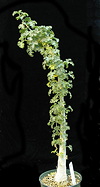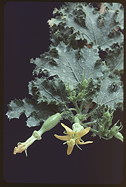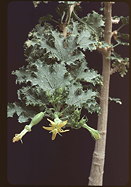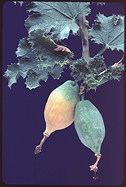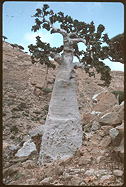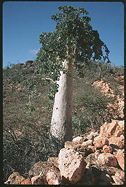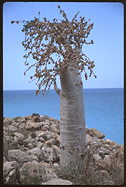The term “tree cucumber” may sound like a contradiction, as most cucurbits (members of the Cucurbitaceae or cucumber family) are lax, vining plants with or without a caudex. But D. socotrana does indeed reach tree proportions with a thick pachycaulous trunk topped by a mop of thin branches bearing prickly, palmately lobed leaves. Such a specimen was illustrated in the Cactus and Succulent Journal in the first of Gary James’ two-part series on Socotra in 2000 (72 (3):150). Otherwise, this species has been rarely illustrated. Nevertheless, it has established a tenuous toehold in cultivation.
The Huntington maintained, until recently, a small specimen collected by Lavranos during the 1967 expedition to Socotra that first introduced some of this island’s unique flora to modern succulent collectors. The late Frank Horwood was more successful with some of the plants from that expedition and was the first to produce flowers and fruits in cultivation when his collection was housed at Abbey Garden Nursery in the early 1980s. More recently, Tim Metcalf from the UC Davis Botanical Conservatory and his successor, Ernesto Sandoval, have had exceptional success with some of the original 1967 material. Their plants now regularly flower and bear fruit through hand pollination.
The secret to successful cultivation of D. socotrana at UC Davis seems to be to disregard the extremely xeric nature of these and other better-known pachycaulous succulents from this desert island (Adenium socotranum, Dorstenia gigas). Given ample watering and fertilizing, two or three times a week, in a warm greenhouse yields remarkable growth, resulting in flowering specimens in just a couple of years. We offer HBG 91547, grown from controlled pollination of UC Davis # B 67.397, UCBG 67.476, from Ras Hebek, Socotra. $30.

Published in the Cactus and Succulent Journal, Vol. 77 (2), March - April, 2005
